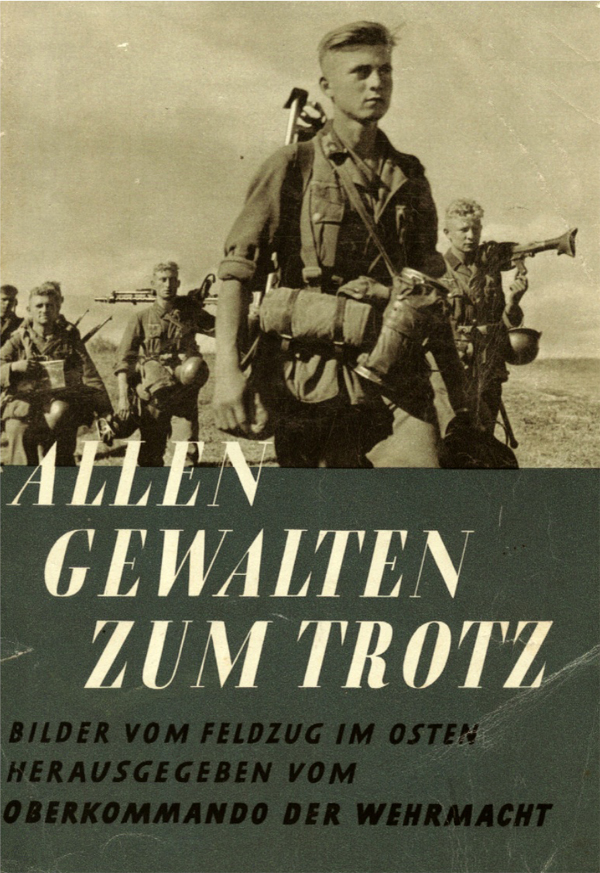Slave to the Game
Online Gaming Community
ALL WORLD WARS
AGAINST ALL ODDS
Pictures of the Campaign in the East, 1942
PUBLISHED BY THE SUPREME COMMAND OF THE WEHRMACHT
"I therefore decided today to once again lay the fate and future of the German Reich and our people in the hands of our soldiers."
from the Fuhrer's speech to the German people, June 22nd, 1941.
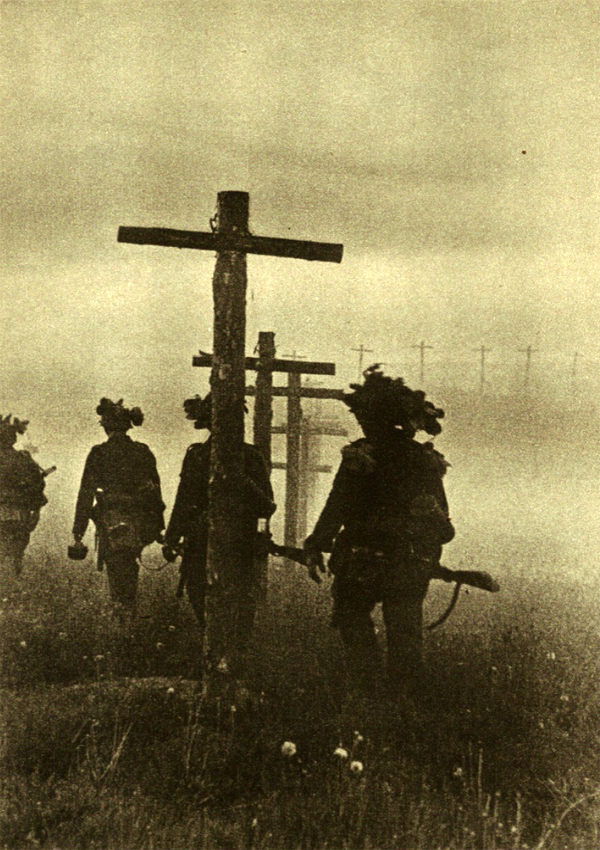
Dawn of June 22nd. Crossing the border of the Soviet Union
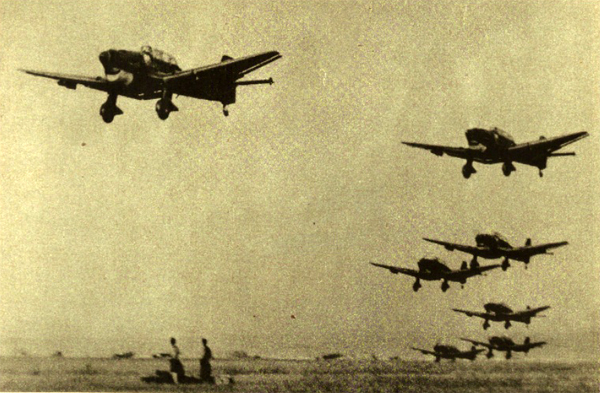
Squadrons of the German Air Force rush at the Soviet enemy
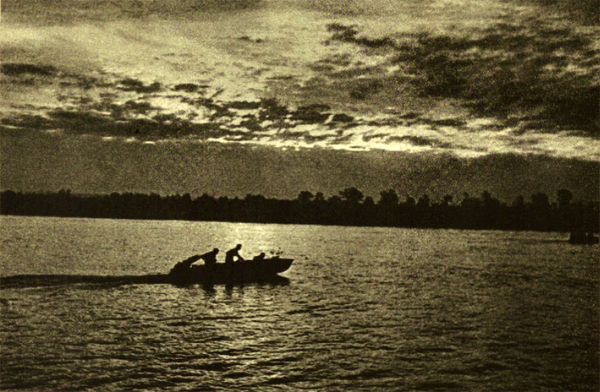
The border river Bug is crossed on the storm boats
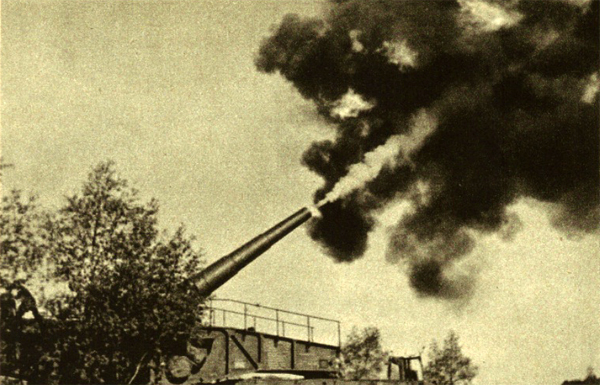
The fight has begun - a railway gun fires at a distant target
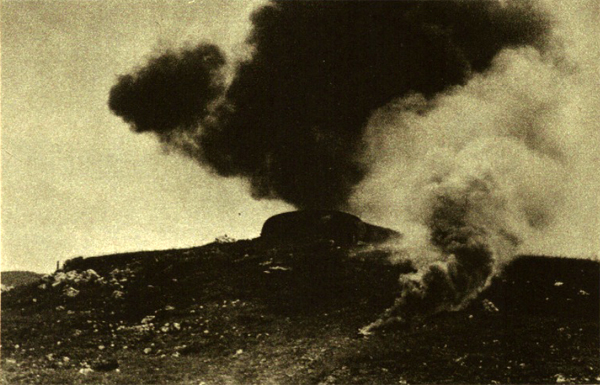
After engineers, carrying explosive charges and flamethrowers, attacked enemy bunkers on the border, resistance was broken on the first day of the offensive.

Navy also got involved from the first day of the battle - torpedo boats make their thrust against the Soviet fleet.

Infantry goes forward under the fire, heavy machine guns beat off counter-attack

On June 23rd Grodno was taken after hard fight - German troops enter the burning town.

June 24th. Storm of the Brest-Litovsk fortress
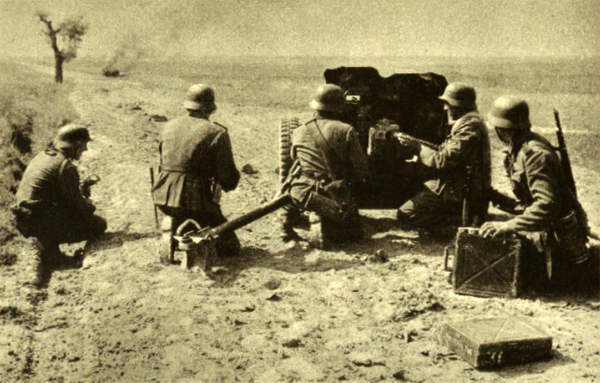
Anti-tank gun sets enemy's tank on fire. From June 22th to 25th German destroyed about 1300 Soviet armored vehicles
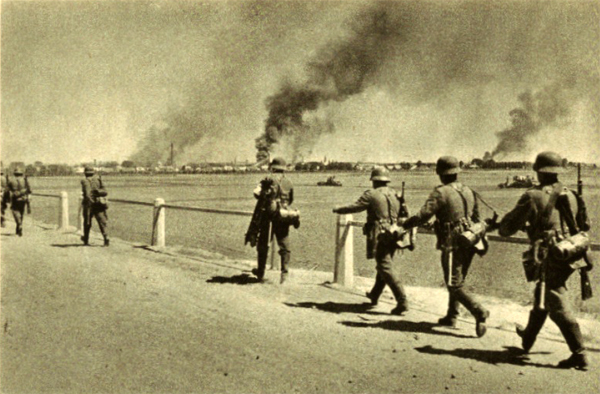
On June 26th Dunaburg (Dvinsk) falls into German hands

Combat patrols crossing river Styr in the inflated boats. Town of Luck was occupied on the June 29th
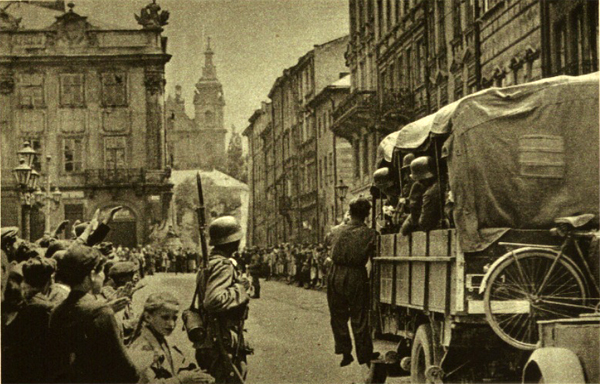
Lvov residents greet winners when fighting still goes on the other side of the city. On June 30th Bavarian mountain troops put Reich battle flag on the highest point of Lvov's Castle
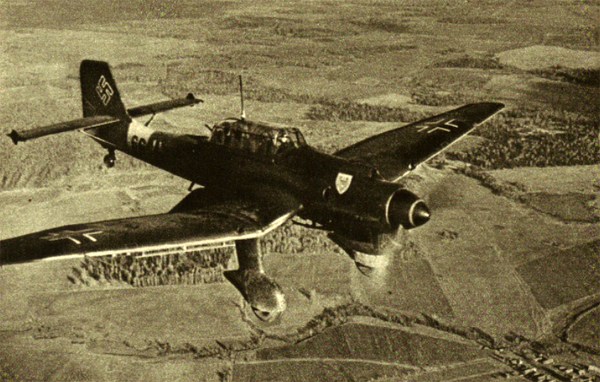
Dive bombers are preparing to attack enemy's transport routes

View of the bombed up segment of the railway line on the North front

Bolshevist train got smashed by German pilots
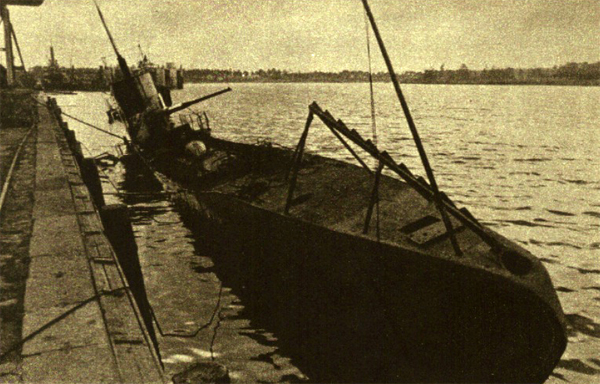
On June 29th Libau is taken - destroyed hostile submarine lays dead in the city harbor

Reich labor units closely follow the fighting troops
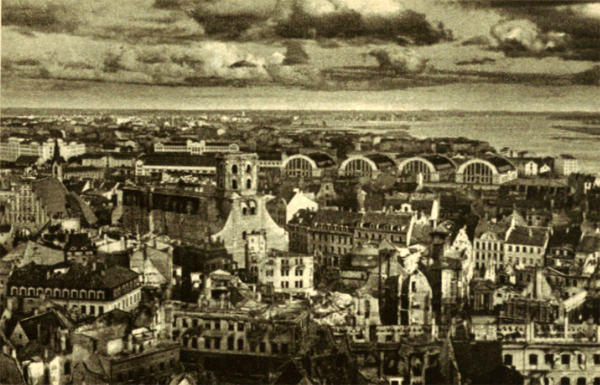
On July 1st the old Hanseatic town of Riga is liberated from the Bolshevist rule
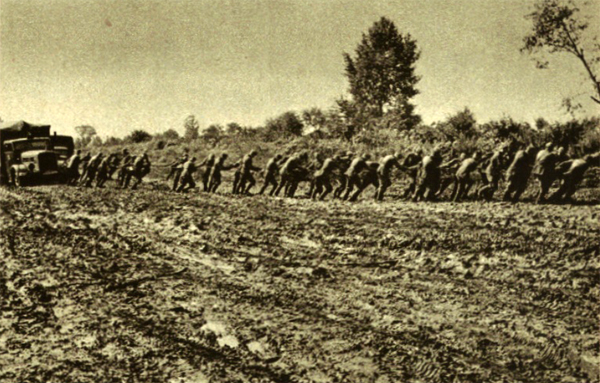
The roads condition complicates the advance. The mud of Soviet Russia is a tough opponent by itself
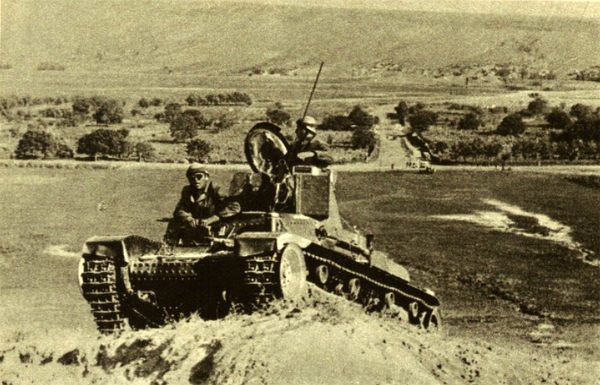
On July 2nd Romanian troops crossed river Prut together with German troops and penetrated into Bessarabia. Now the allied troops form the continuous front line from the northern Antarctic Ocean down to the shores of the Black Sea

The residents of Faleschti (Bessarabia) greet their liberators

On July 3d German cavalry unit crosses Beresina river
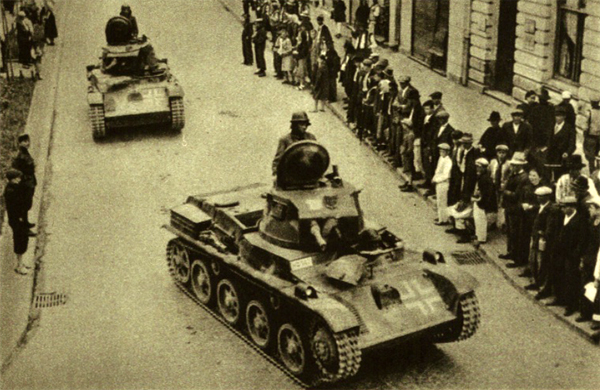
Hungarian troops took Kolomea and Stanislav on July 4th - Hungarian tanks move into Kolomea
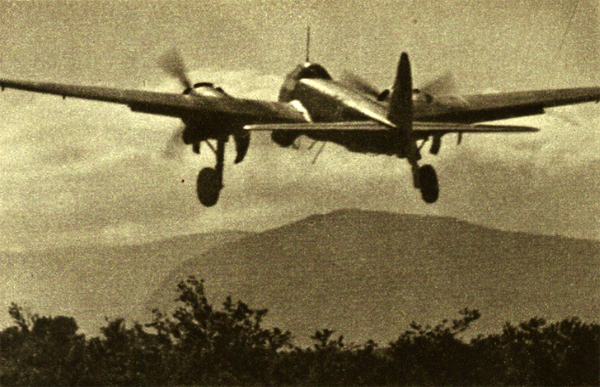
Murmansk front. Ju 88 takes off for the bombing attack on a Soviet airfield

German destroyers in operation against the Bolshevists in the Polar Sea
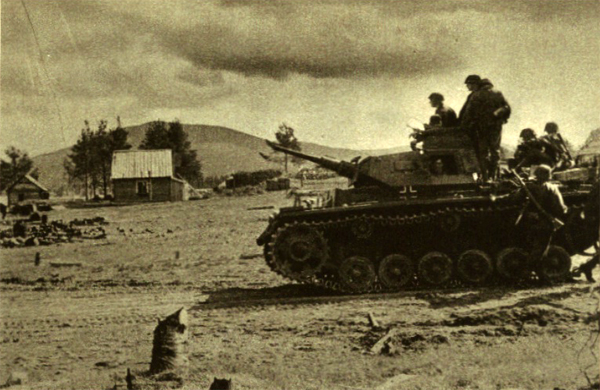
ln the high north Finnish and German troops fight side by side - German tanks march to Salla on July 8th
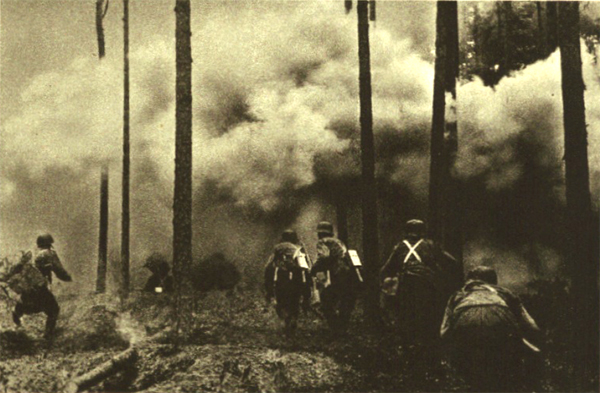
Finnish combat patrol goes forward under protection of the smoke screen
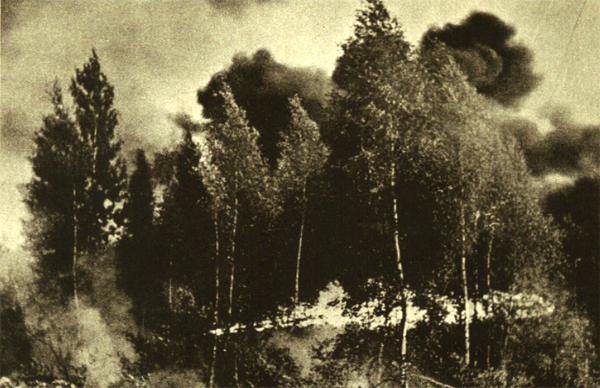
Flamethrower troops fight against Soviet position in the Finnish forests
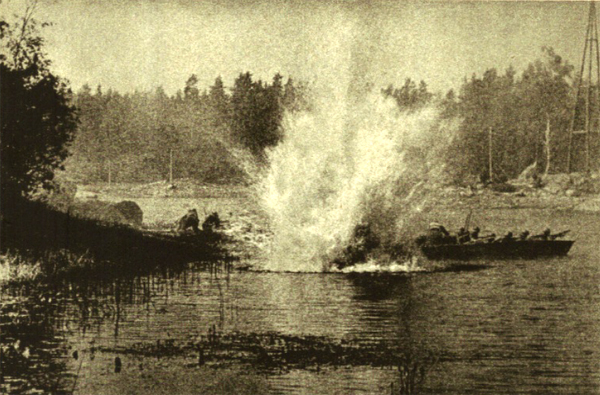
Finnish storm boats cross a forest lake under the hostile artillery fire
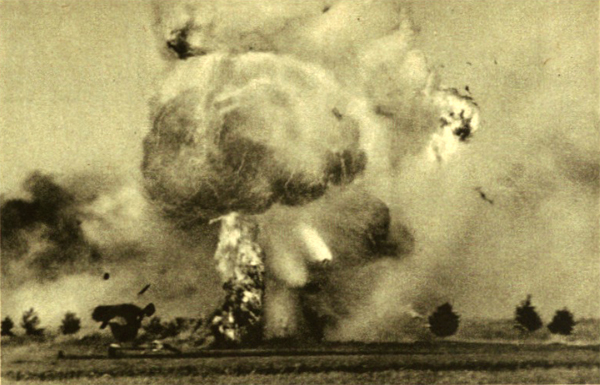
Panzerjagers destroy a Soviet tank

Heavy tanks in night fight
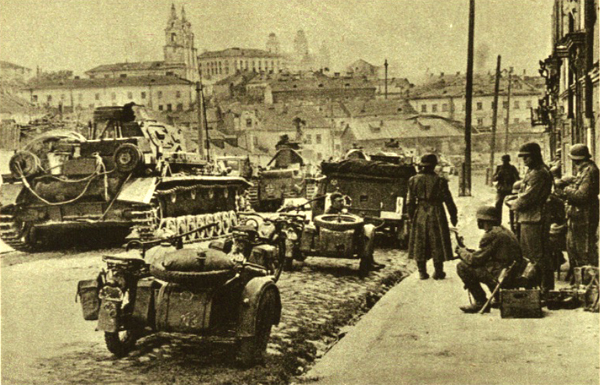
German troops in Minsk

View of the Minsk airfield
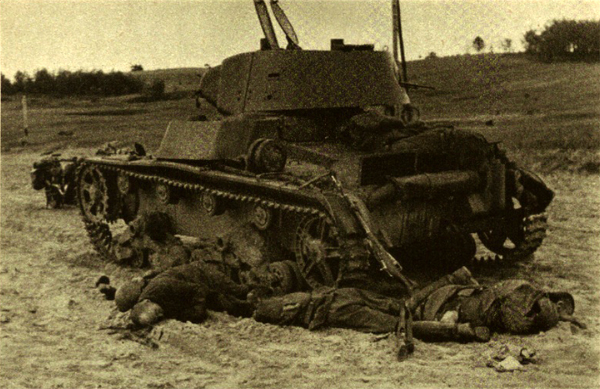
End of the Soviet tank and its crew

Bolshevists, caught in the Rozany area, south of Bialyistok

On the path of Soviet army retreat - this Soviet heavy tank was left behind
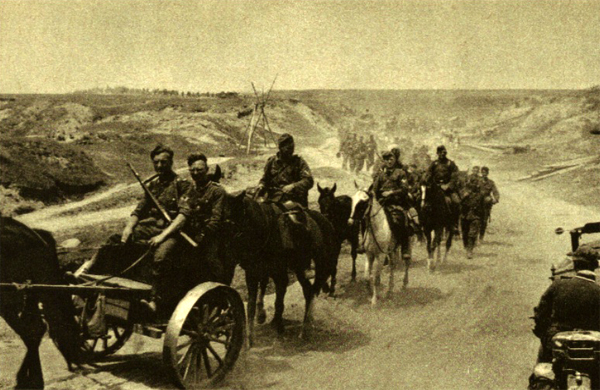
Advance in all segments of the immense front - horse-drawn units of an infantry regiment
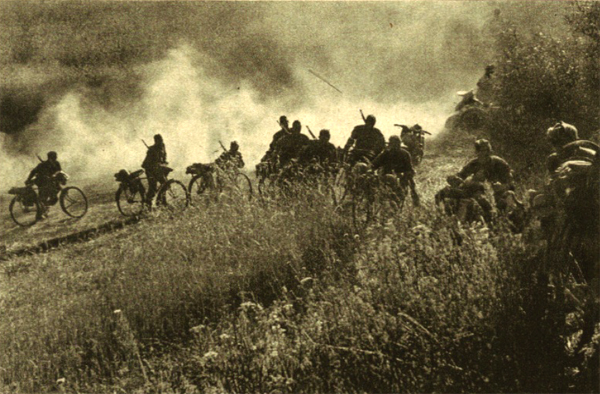
A cyclist unit works its way up the slope
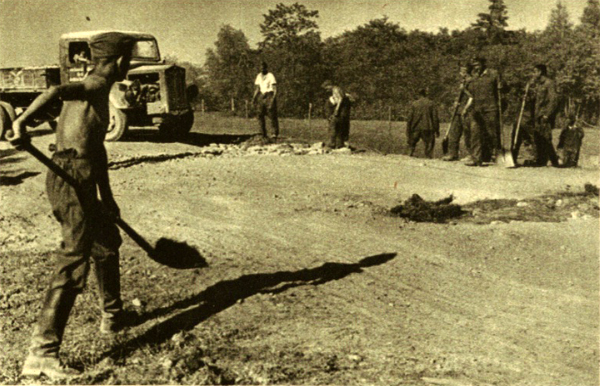
Members of the Todt organization keep a path for the German advance in good condition
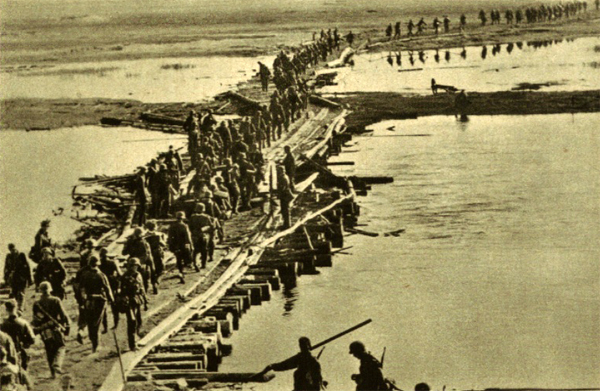
During the action near Rogatchev, an important strongpoint of the Stalin's Line, infantry crosses the Drut river
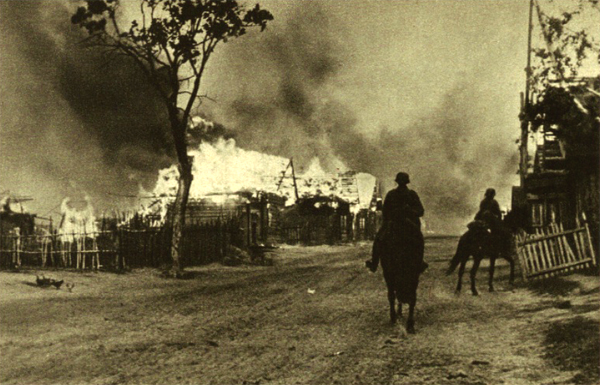
German cavalry in Mogilev
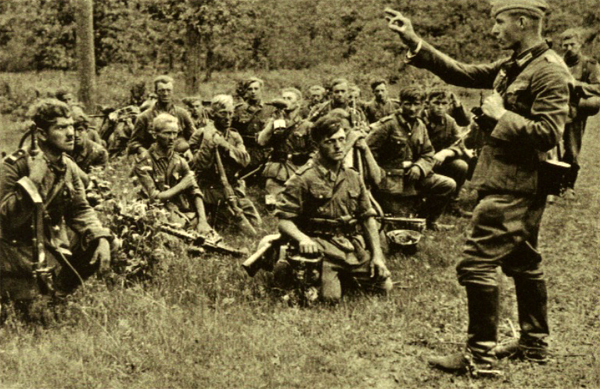
On the 12th July Stalin's Line is broken through in all important sectors. After Soviet unit in the Upper Dnepr area was defeated, leader of the storm party gives instructions before crossing the river

Fallen Bolsheviks on the battlefield near Mogilev

German anti-aircraft artillery in the fight near the burning Vitebsk

Bolshevist POWs
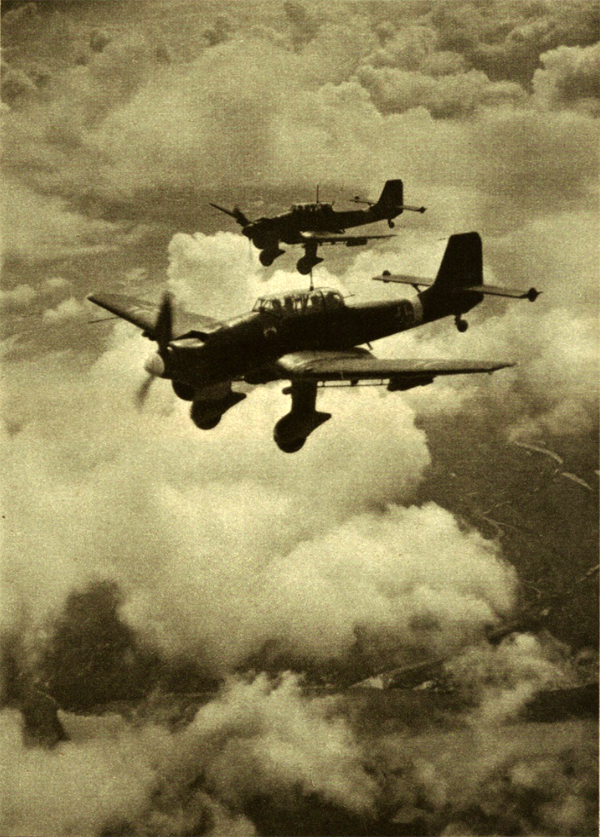
Attack of the dive bombers on the Dnepr bridge
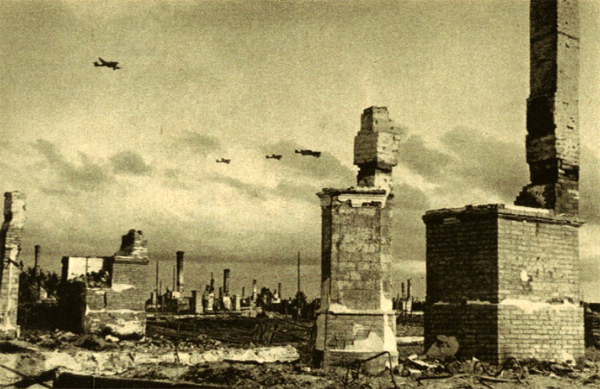
On July 11th Vitebsk is in German hands
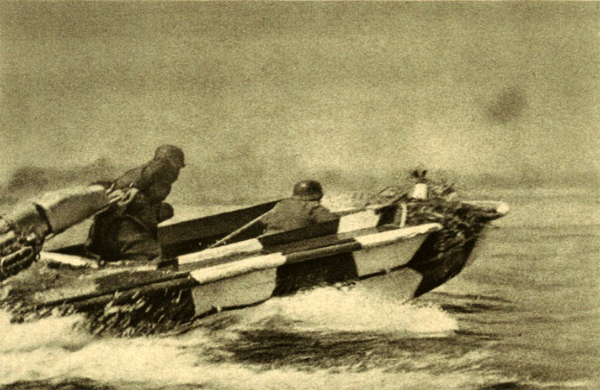
On July 13th Finnish armed forces line up on both sides of Lake Ladoga preparing for the attack - storm boat on Lake Ladoga

On the north sector of the front near Plescau (Pskov), German troops passing the burning village

German heavy guns battery changes position
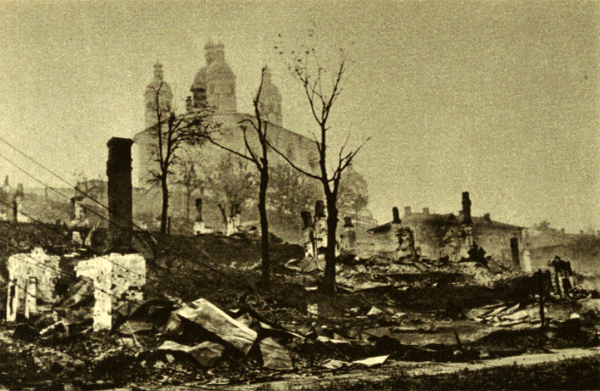
On July 16th Smolensk is taken

German military graveyard near the Kremlin wall of Smolensk
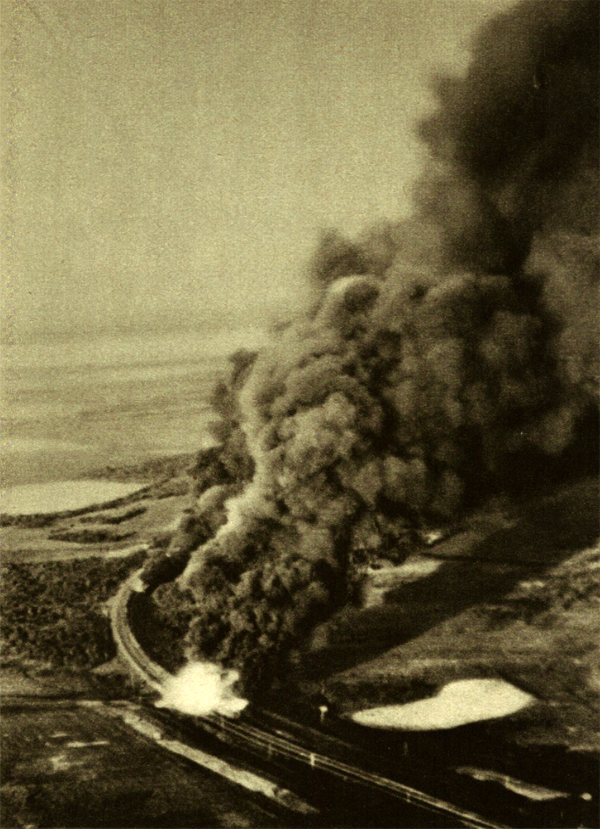
Bombs fell on a bolschevist transport train - ammunition carriage is blown up
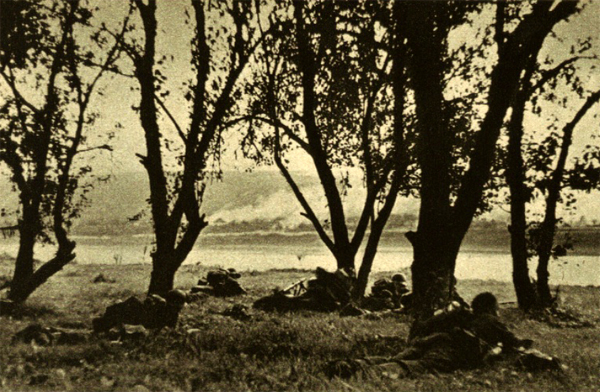
On July 18th German and Romanian troops assemble before crossing Dnestr river
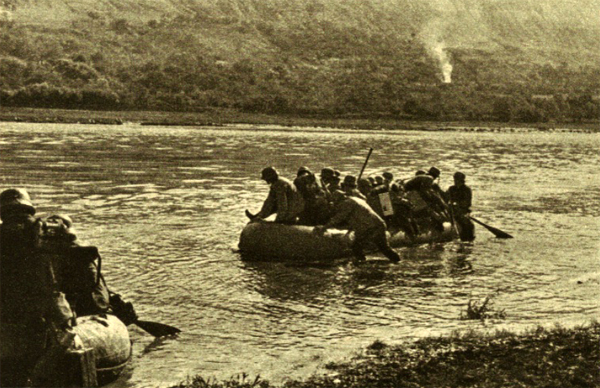
Using inflated boats German infantry crosses the Dnestr, while German and Romanian artillery fire on the opposite shore
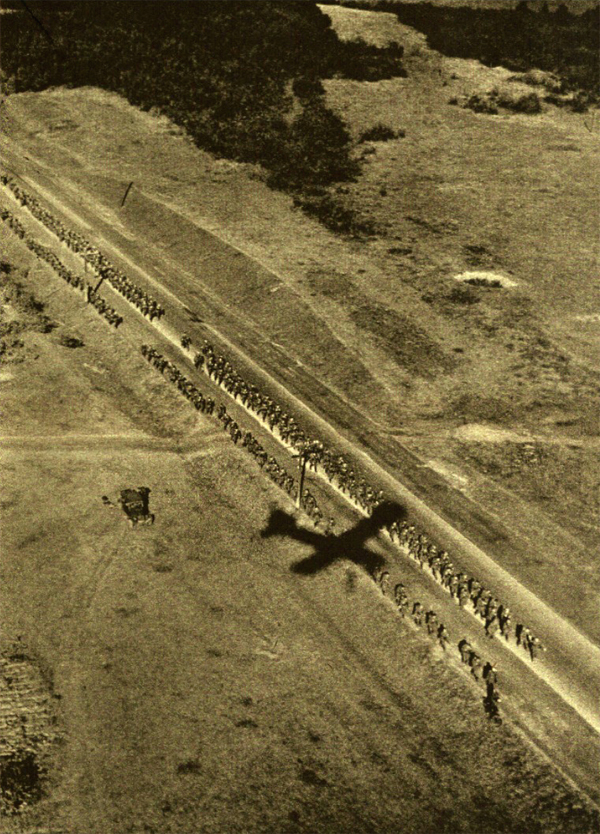
The "Storch" airplane, eye of the German command, throws its shade on the road
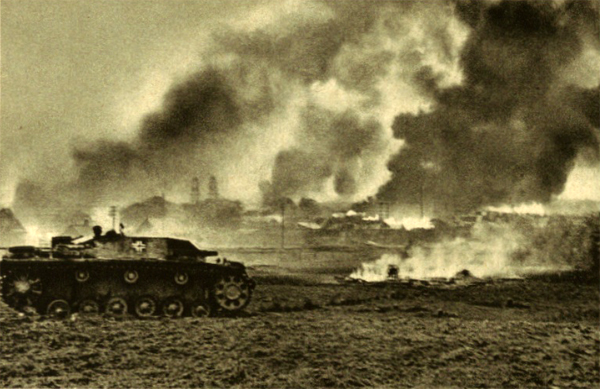
The face of the war - burning town and villages

Battlefield after the fight
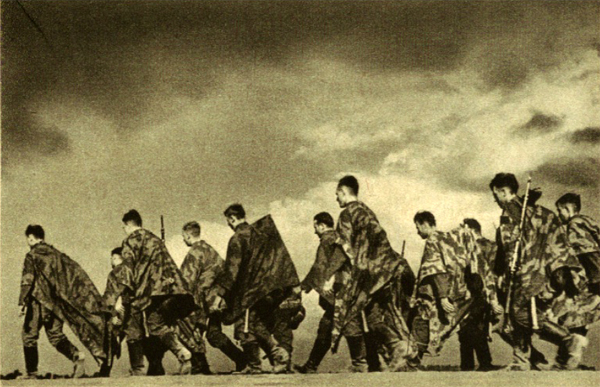
And on and on - inexorably - troops go to the east
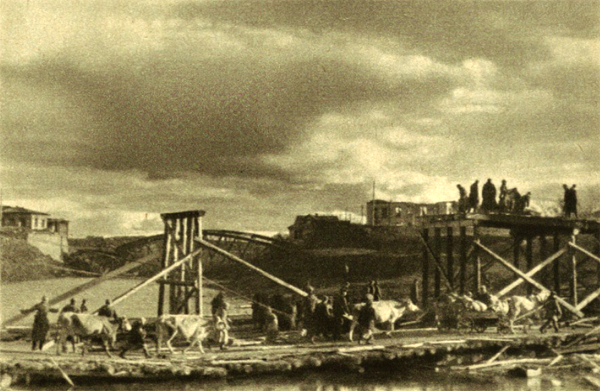
After four weeks the German front stands 700 kilometers deep in enemy territory. The lifelines which connect them with the native country wouldn't break up: engineers building a new bridge next to temporary
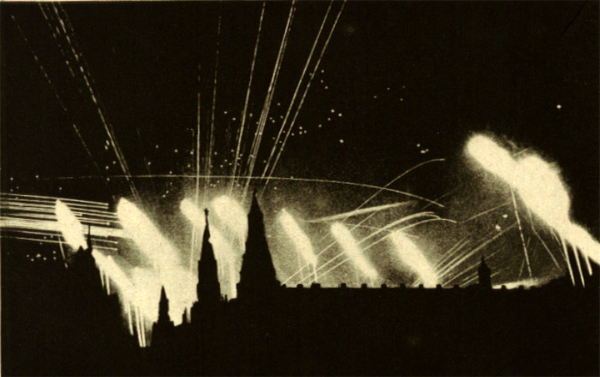
During the first air raid on Moscow on July 12th, German aircraft bombs the Kremlin area. In the night sky lines of the tracer bullets, anti-aircraft shells detonations (point-shaped), light bombs and rays of the spotlights vividly stand out.
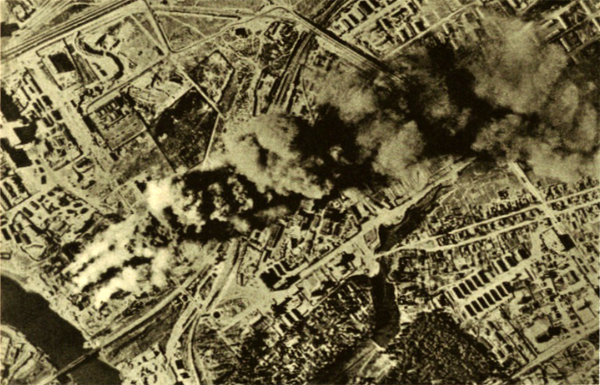
Moscow manufacturing plant is on fire after night bombing
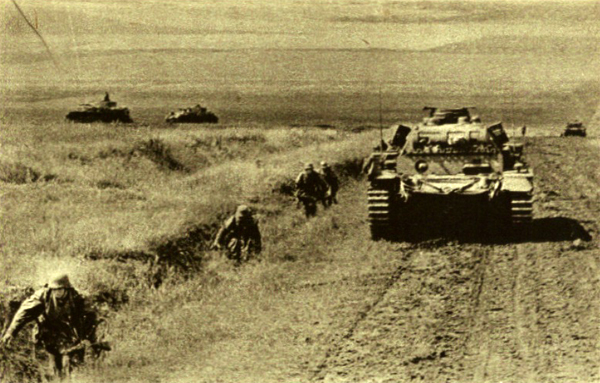
In the Ukraine German, Italian, Hungarian, Romanian and Slovak troops continue their advance. Near Medvin infantry goes forward under protection of the armored vehicles
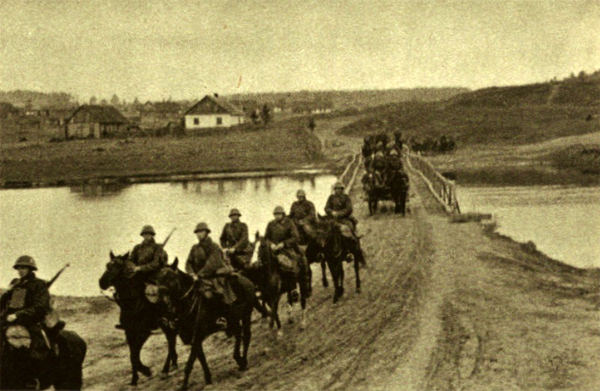
Slovak artillery battery on advance
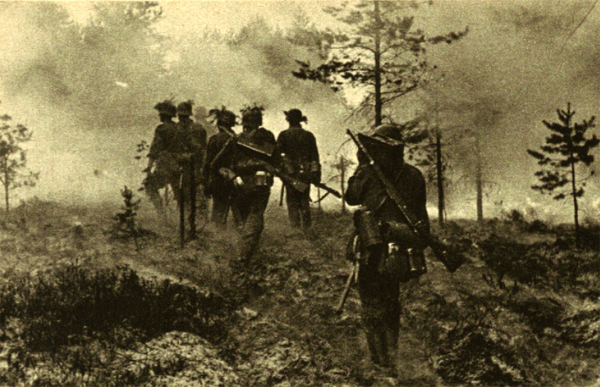
German troops make their way through burning woods during Narva fighting
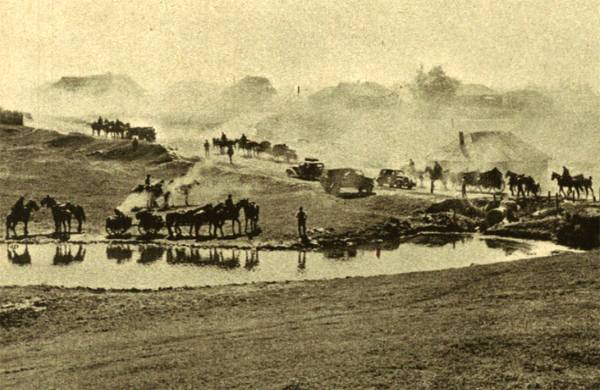
Advance after Smolensk battle
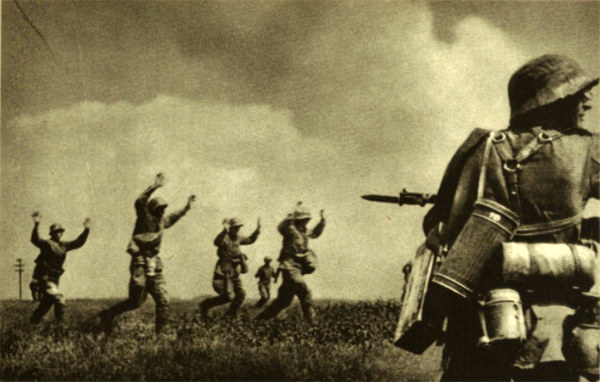
There is no escape form the Smolensk pocket east of the city, Bolshevists surrender in droves. The results by the first days of August, when battle was almost over: about 310,000 prisoners, 3205 armored vehicles, 3120 guns

Prisoners taken after Smolensk battle

Cavalry troops moving in the burning village

With the help of grenades, hostile strongpoint was destroyed
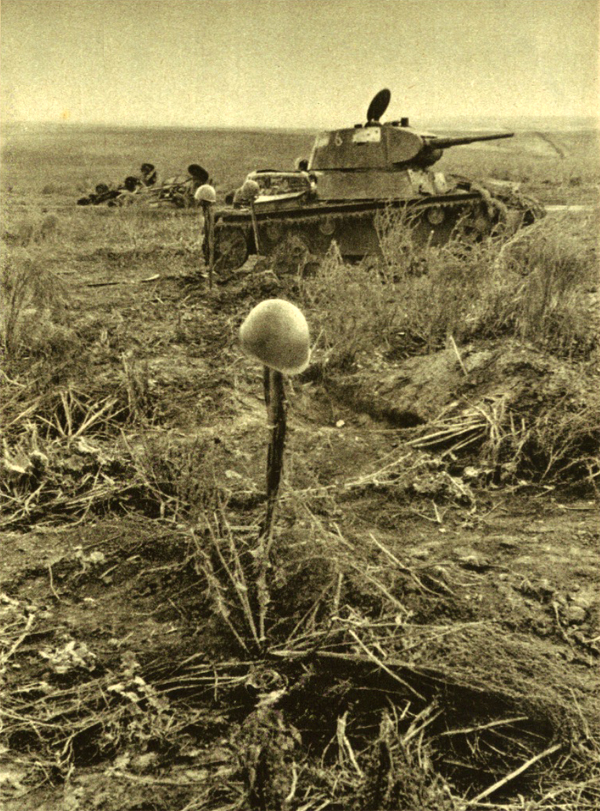
Bolscheviks graves on the battlefield of Uman (Ukraine), where in the first week of August week 25 Soviet Rifle, Mountain and Armored divisions were destroyed. More than 103,000 prisoners were taken, among them commanders of 6th, and 12th army. 317 armored vehicles, 858 guns, 242 anti-tank and anti-aircraft guns, 5250 trucks and 12 railway trains fell in German hands

Henschel 126 on the reconnaissance mission near the polar circle
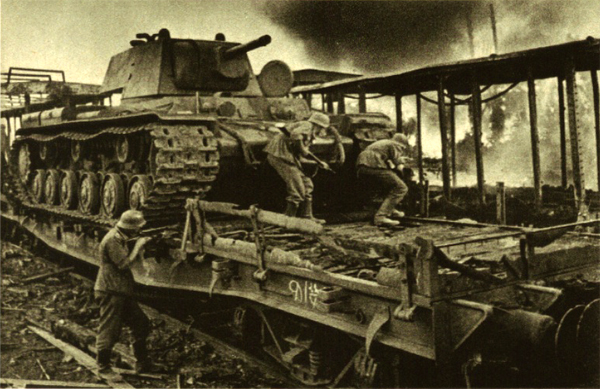
German infantry capture Soviet transport train on the east outskirt of Smolensk
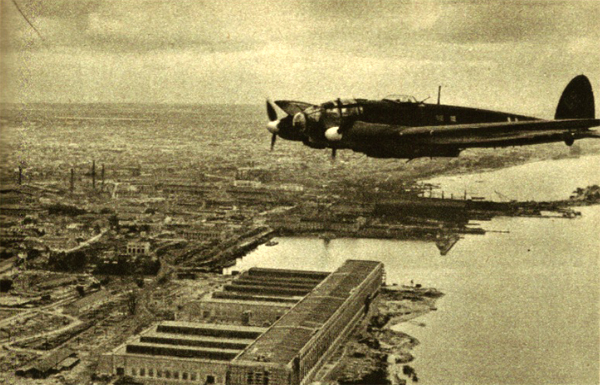
He-111 over the Nikolaev harbor
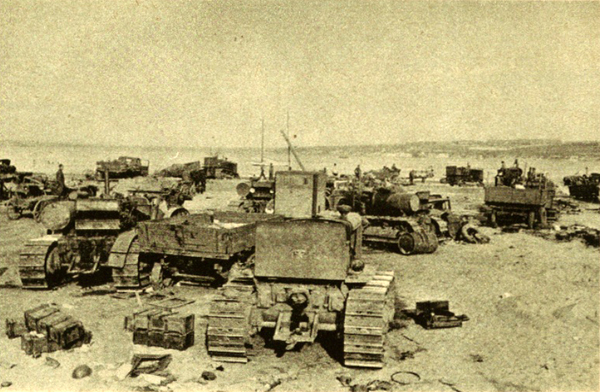
On August 16th Nikolaev, important naval port and commercial harbor in the Black Sea, fell into German hands
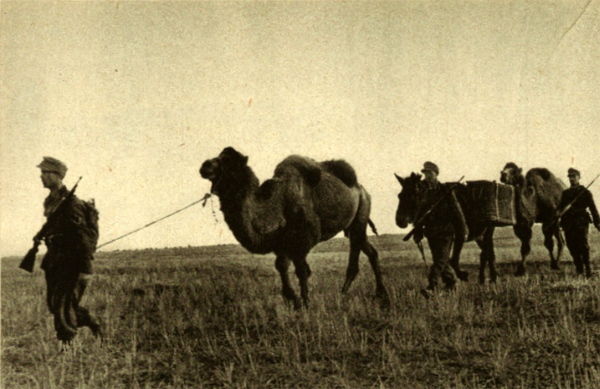
Mountain troops know how to handle not only mules, but camels as well
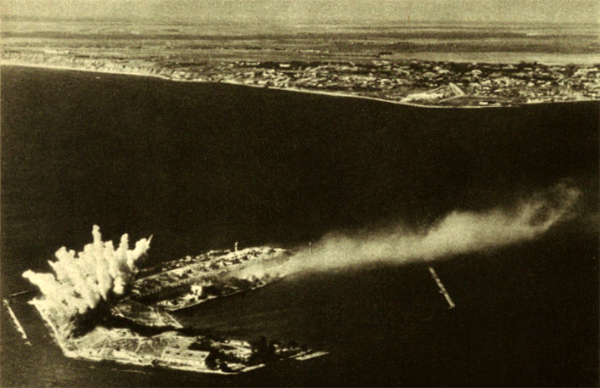
Dive-bombers attack Soviet fort on the Black Sea
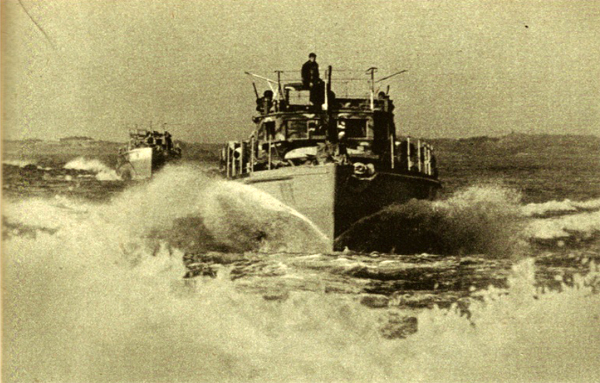
Hunt for the Soviet mines

The dam near Zaporozhie to the south of Dnepropetrovsk was taken on August 25

Since Gomel streets were mined, German storm gun makes a new way

Tanks and Pak thwart the breakthrough of the Bolshevlst troops encircled between Zhlobin and Gomel (August 16th). In the encirclement battle near Gomel 64,000 prisoners were taken
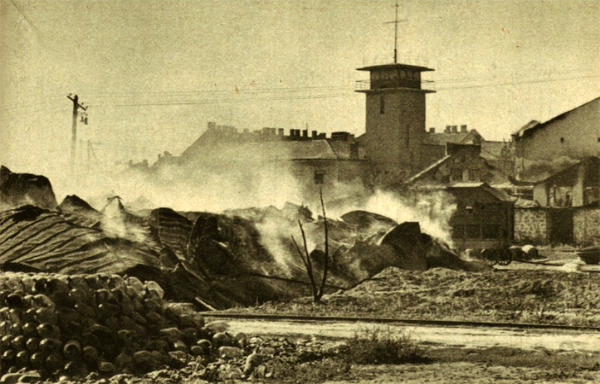
On August 20th port and industrial town Cherson in the lower Dniepr was captured

Fight for the bridgehead near Berislav on the river Dniepr

Anti-aircraft artillery protects a field airport to the south of Kiev
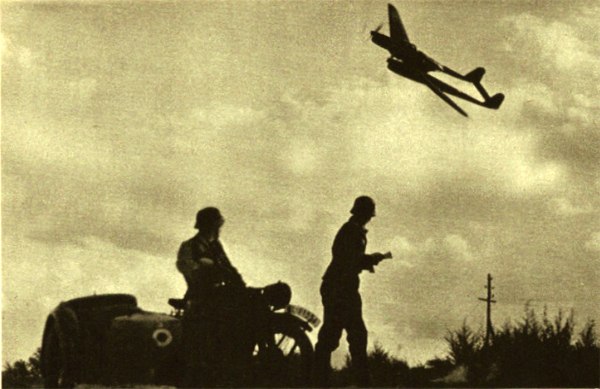
German front troops in the Bielaya Zerkov area, to the south of Kiev, receive smoke signal from the reconnaissance airplane
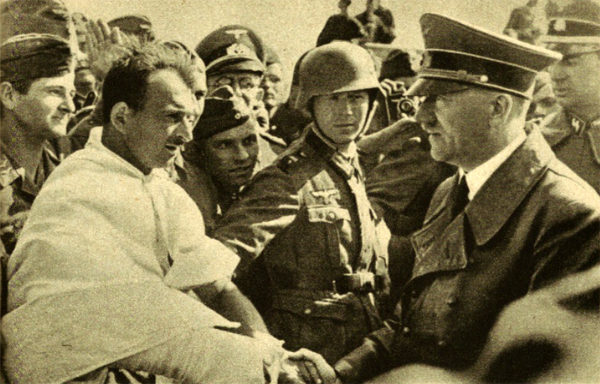
Fuhrer is greeting the wounded on the Eastern front
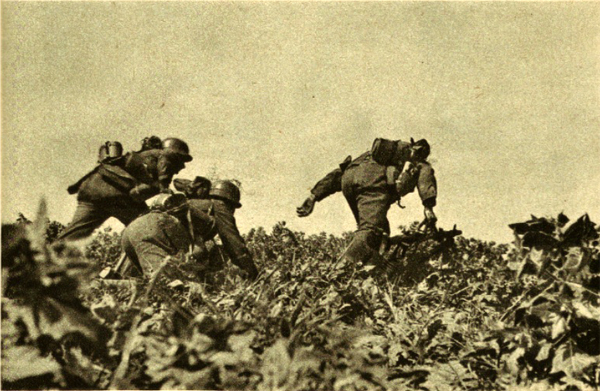
Infantry during the attack south of Kiev
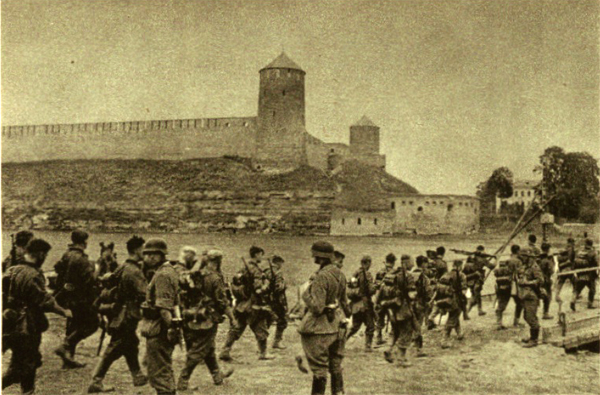
On August 30th Narva is taken. Ivangorod fortress is on the background
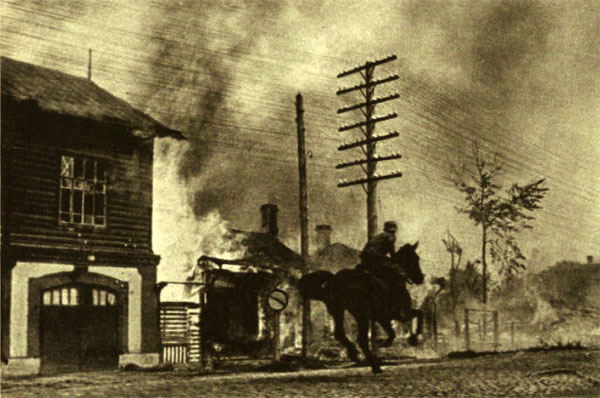
German horse messenger riding in the burning Kingisepp, east of Narva. On the same day this town was taken.
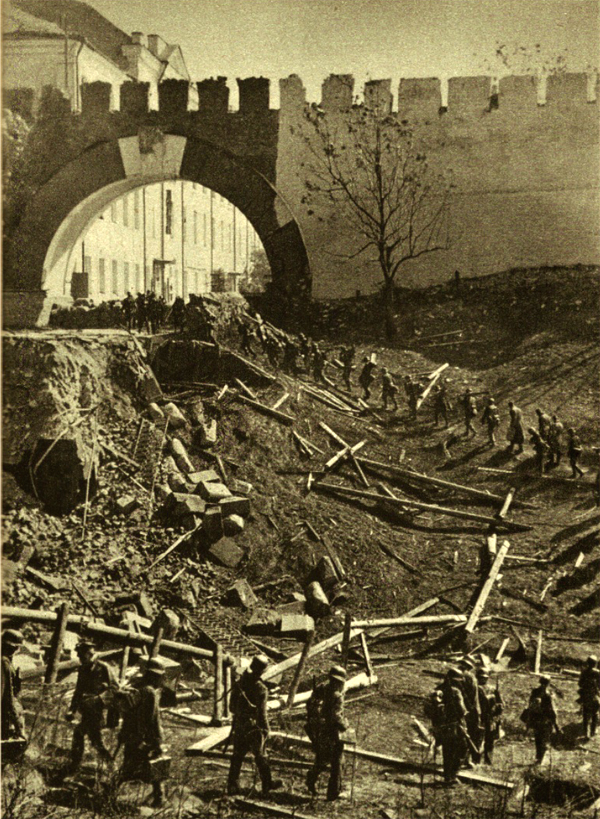
German troops enter Novgorod Kremlin. The old commercial city to the north of the Ilmen lake,
in the Middle Ages the easternmost Hanseatic center, fell n German hands on August 20th

Graves of the German soldiers in the east
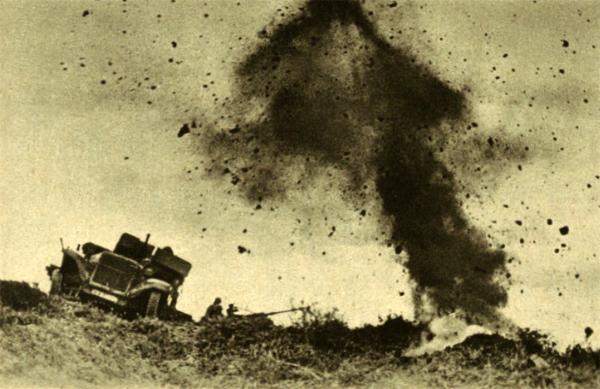
Light anti-aircraft gun, used in the fighting, provides defense from a hostile attack
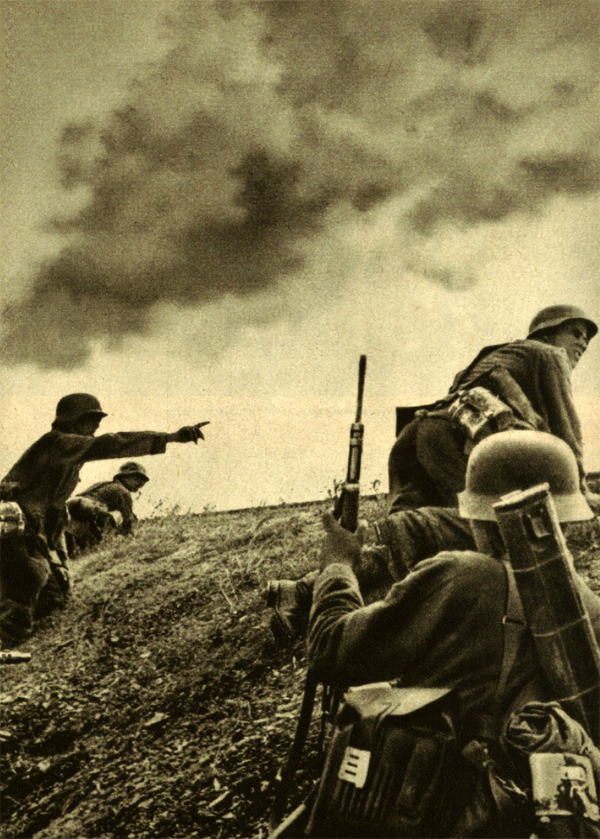
The storm of Velikie Luki (to the north of Vitebsk). Eastward of the town by the 26th August Soviet 22nd army was destroyed. More than 3000 prisoners and 400 guns fell in German hands
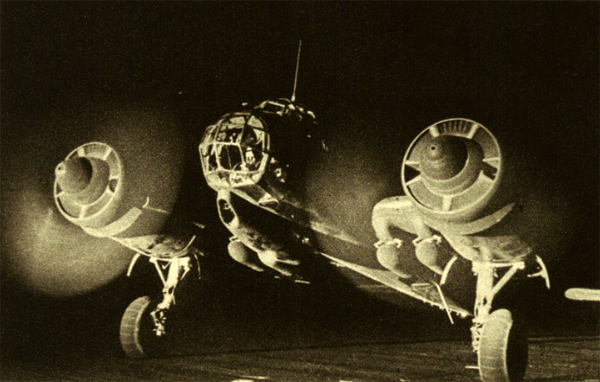
German aircraft before the night-time operation
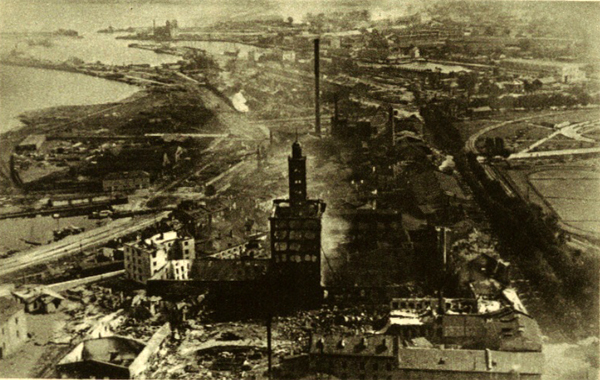
The harbor of Reval (Tallinn) after the German bomb attacks. On August 28th Reval is taken by German troops in the cooperation with navy and air force

On the East cavalry is indispensable.
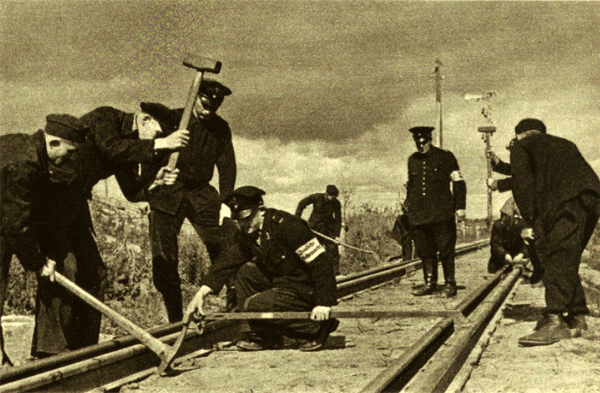
The progress of the offensive depends on the rear transport units. Men of a Relchsbahn construction train adjust Zhitomir-Korosten railway section to the German gauge
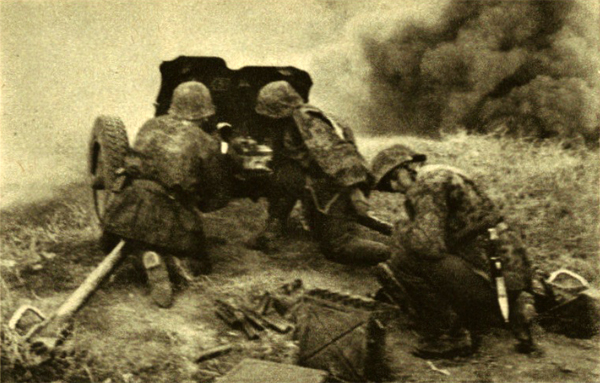
Light PAK of the SS division Viklng in action. Danian, Norwegian, Dutch and Fleming soldiers, fighting under German leadership against Bolshevism, destroyed the remaining pocket of Soviet resistance
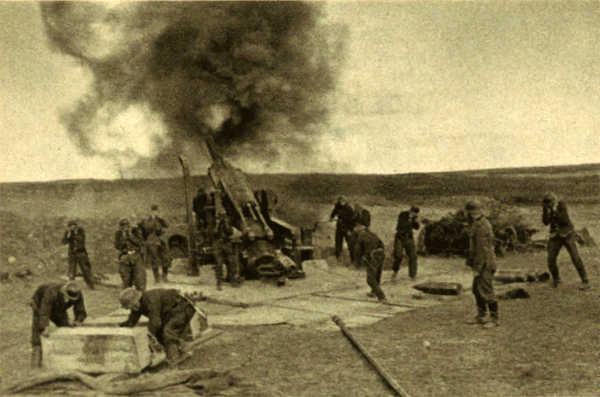
Since beginning of September Lenlngrad is placed under the fire of heavy artillery

Dive bombers attack enemy's field positions to the south of Leningrad

Effect of a German bomb attack on the Dniepr harbour of Krementschug, to the north-west of Dniepropetrovsk. The city is taken on the 8th September
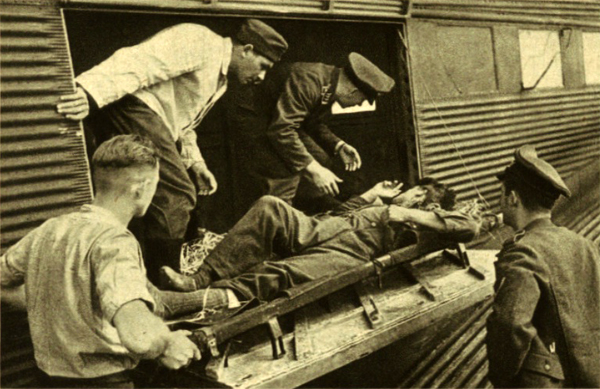
Wounded are carried to the transport plane for evacuation to Germany.

PAK hits a 26-ton tank from the distance of 20 meters

PAK protects the Dniepr shore near Cherkassy, south-west of Kiev.

Artillery battery unlimbers on the fire position before Yagotin. On September 13th the ring around the hostile armies was closed in 200 km east of Kiev.
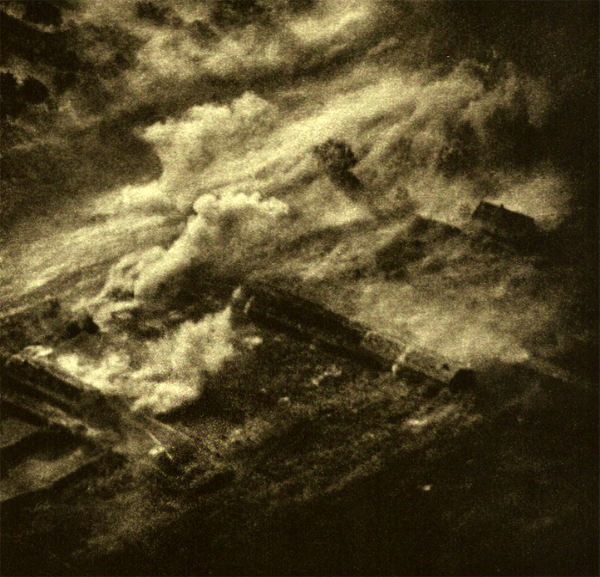
Attack of German aircraft on a Soviet headquarters in the East Ukraine.
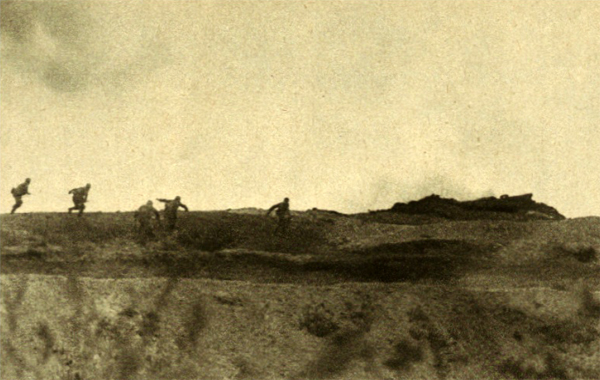
Before Leningrad - combat patrol of engineers takes action against a hostile bunker

Distant view of Lenlngrand (tower of the Admirality and St.Isaak cathedral) from the German front lines.

A reconnaissance plane closely watches Soviet panzers in Kiev area
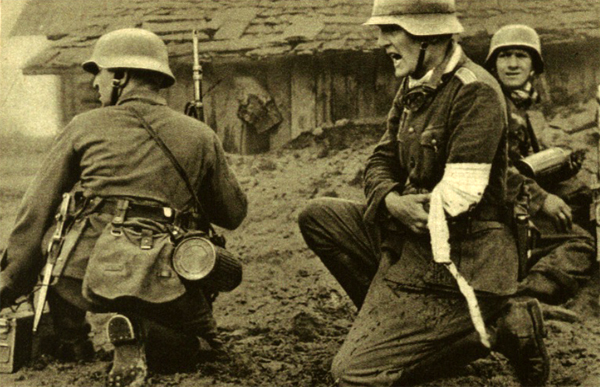
German soldiers in hard fight for a village. The second lieutenant is wounded. Despite of his wound, he continues to give orders.
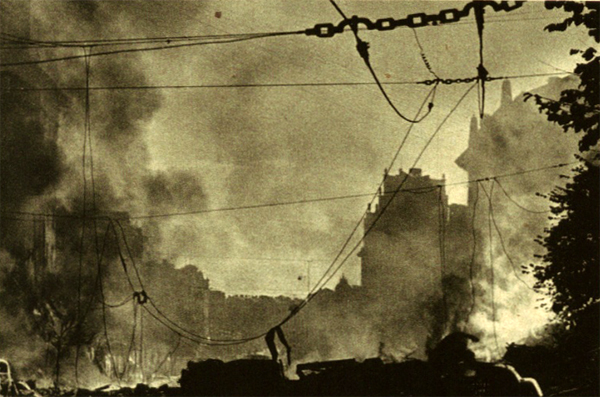
Kiev falls on September 19th
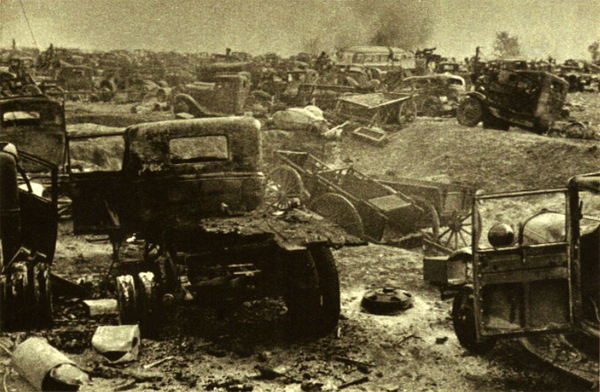
On the Kiev battlefield

Minesweepers in operation against Soviet Russia
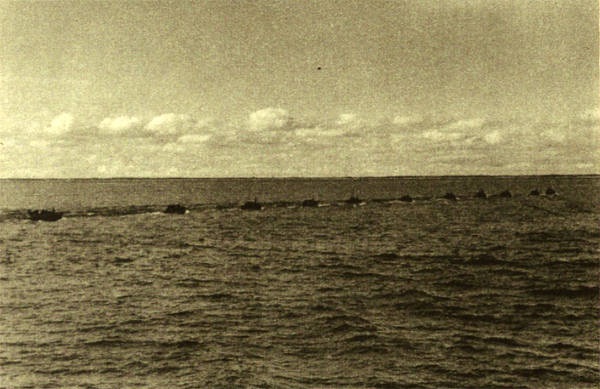
German troops, using these tiny storm boats, go against Oesel Island, which fell in German hands by the end of September

Italian troops on advance, which they carried out from September 28 to 30, eastward of the lower Dniepr, taking 6000 prisoners and inflicting heavy losses to the adversary
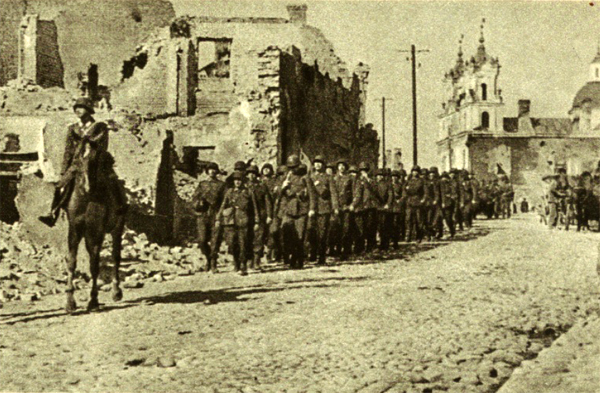
In the north segment of the front Spanish legion takes part successfully in the battle
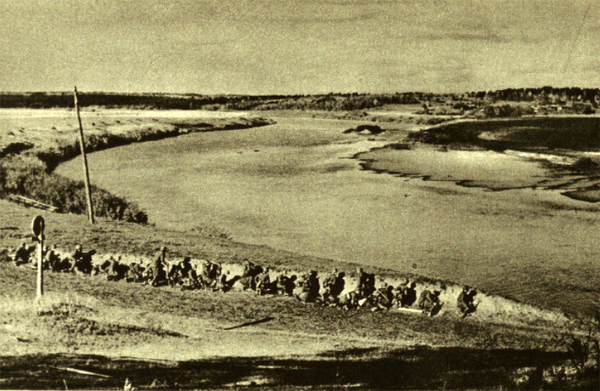
The Ugra river (southwest of Moscow) is reached. The enemy has burnt the bridge and established strong points on the opposite shore. Combat patrol is preparing to cross the river
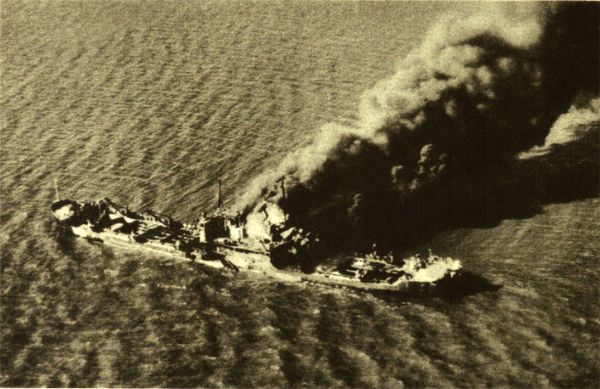
Bomb hit a freighter in the Black Sea
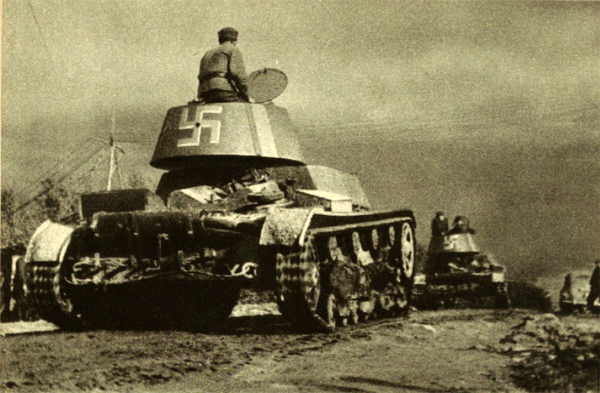
Advance of Finnish tanks: on October 1st Petrozavodsk, the capital of East Karelia is taken.
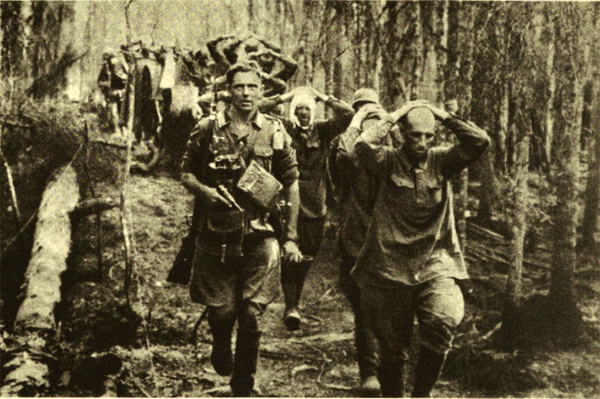
Soviet POWs taken in the primeval forests on the Finnish front
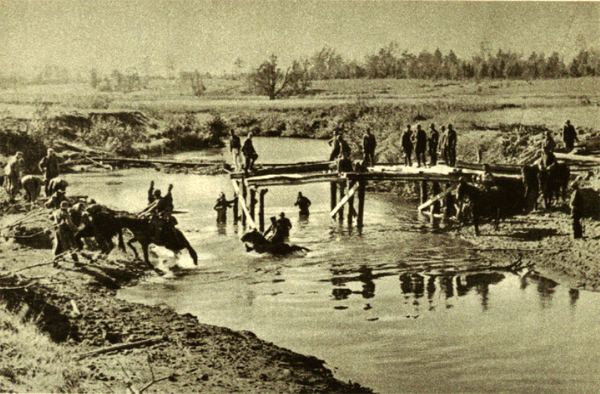
On October 2nd German troops of the central part of the Eastern front go once more to the attack. After destroying hostile strong points German unit crosses Dvina river
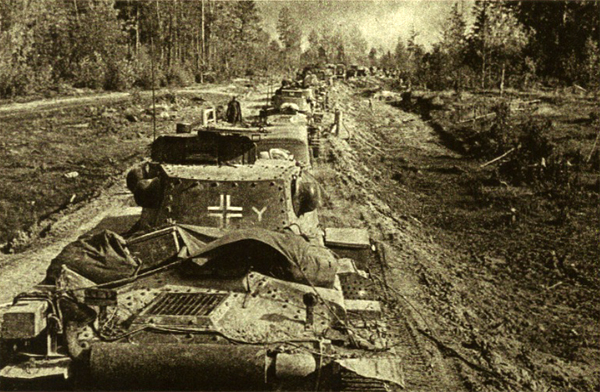
Armored divisions push forward on the north-west of Viasma

At 7,000-meters height against the enemy
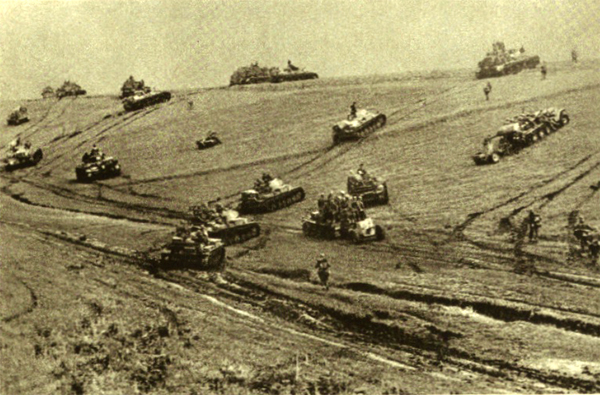
Tanks, PAKs and infantry units assemble for the attack behind a crest of the high ground
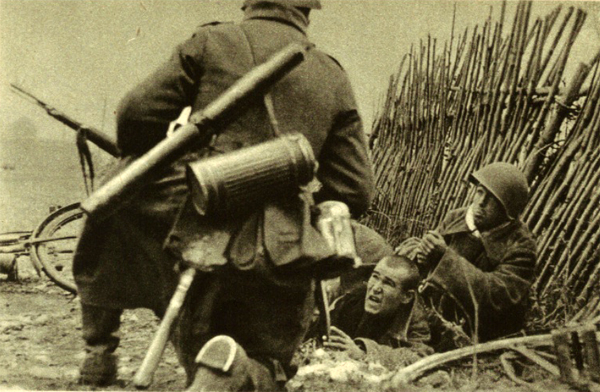
On October 7 the encirclment of several Soviet armies is completed near Viasma - German soldiers getting the stubbornly defending Bolshevists from theirs positions south-west of Viasma
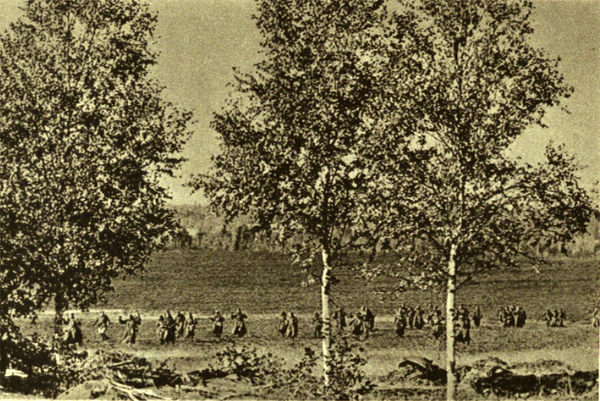
Enemy's troops, encircled near Viasma, surrender in droves.
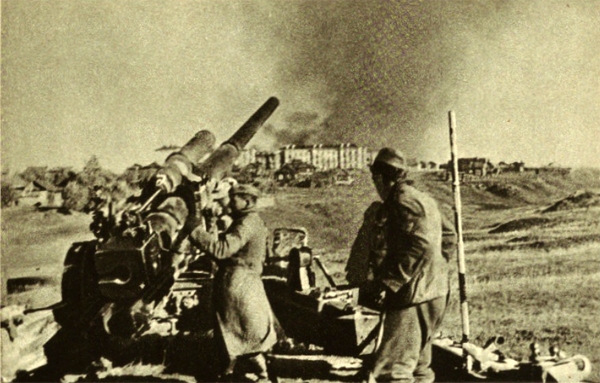
On October 13th Kaluga is taken. Heavy German artillery on the eastern outskirt of the city
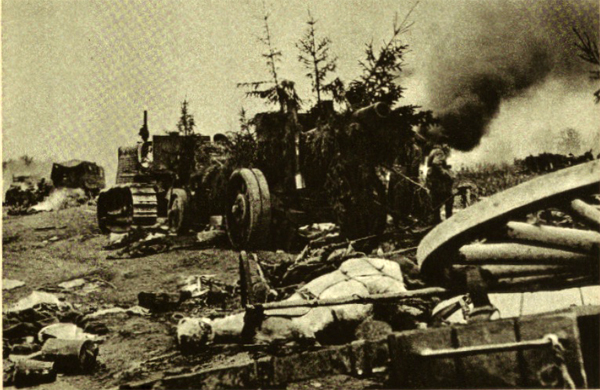
By October 18th double battle near Viasma and Briansk is over. 657.946 prisoners were taken, 1241 armored vehicles and 5396 guns were destroyed

Romanian troops during the Odessa offensive. On October 16th city is taken
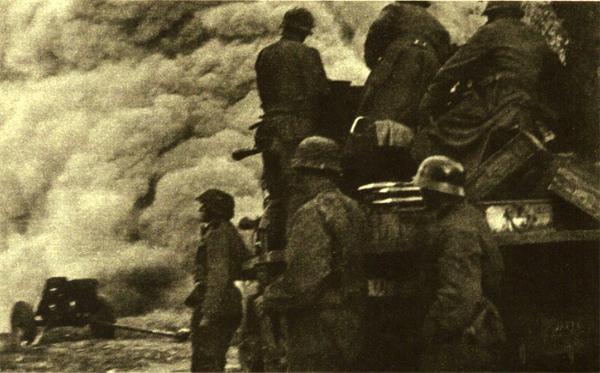
The battle on the Sea of Azov ends on October 11 with a footbridge established by German and Rumanian troops. The pursuit of the enemy between the Sea of Azov and Donez river makes a quick progress- on October 28th Taganrog is taken by the SS units
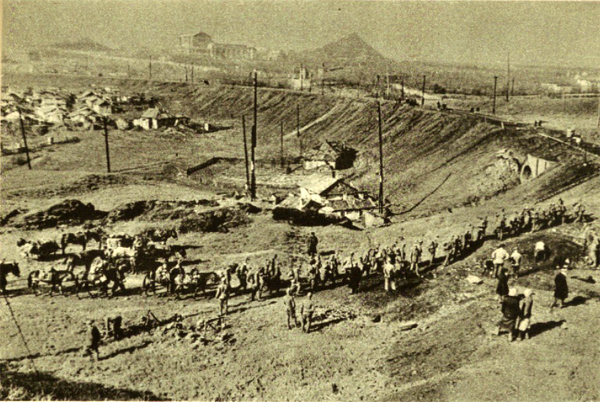
On October 20th Stalino is taken by Mountain troops

On October 22nd the outer defense position of the Soviet capital is broken through
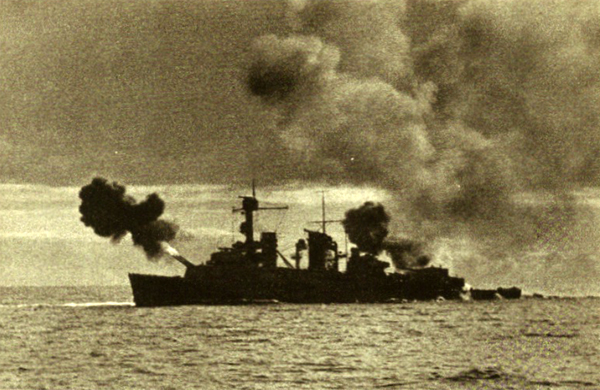
German cruiser opens the fire on a shore battery on Dago Island

Storm boats in the attack on Dago which is taken on the 20th October. Thus the Baltic is completely liberated from the enemy

Infantrymen storm the Tatar's ditch on Perekop Isthmus at the end of September. Defense lines to the south Perekop were overcome between October 18th and 26th of October during the intensive struggle, the access to the Crimea peninsula is cleared from the enemy

The German front lines are stretched from the Barents Sea down to the south coast of Crimea - observer of the Mountain troops unit takes position on the Fisherman's peninsula
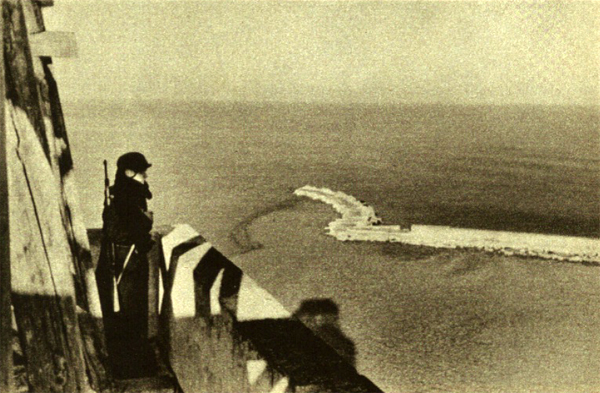
Artillery of the German Navy in the Black Sea

Battle posts of the infantry were facing Soviet positions in the Jaila mountains near Sevastopol until the middle of November, when almost all Crimea except Sevastopol and Kerch fell in German hands
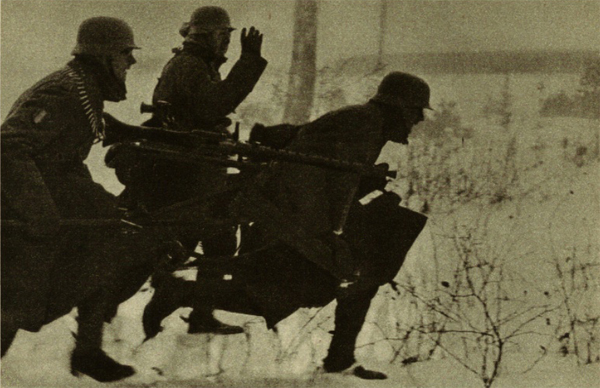
French and the Croatian volunteers participates in the European fight against the Bolshevism
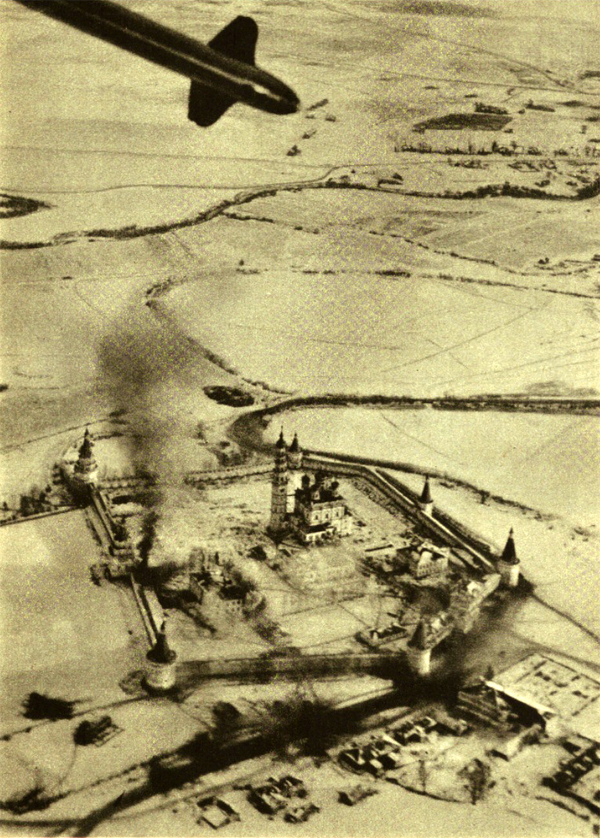
Dive bombers attack Teriaeva monastery north-west of Moscow, which was turned by Bolsheviks into the fortress. The scenery is already covered with snow, the winter has arrived.
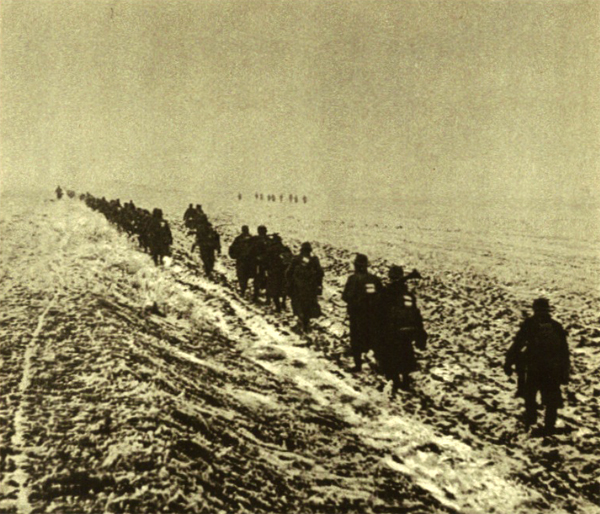
The continuation of the operations in the East from now on depends on the Russian wlnter.
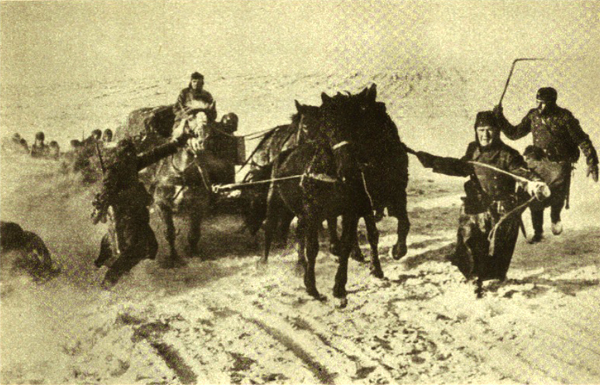
Fighting with the winter
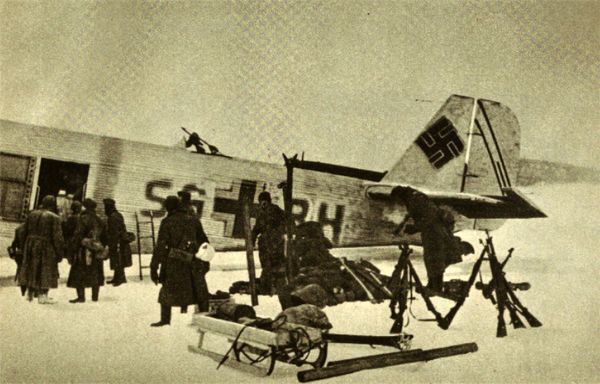
Where the ways are impassable, transport airplanes, like this Ju-52 carry the supplies

Our aircraft operate in extreme winter condition
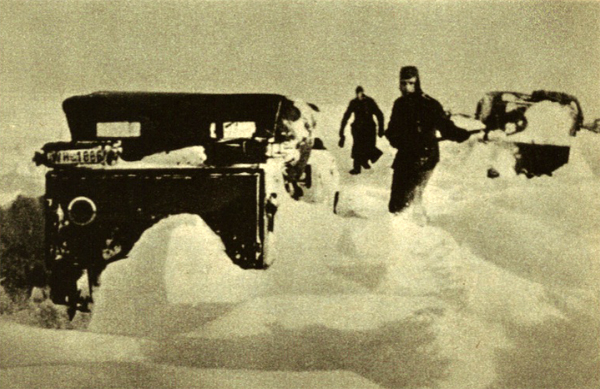
These snow piles must be removed, before the column can continue its march after the blizzard
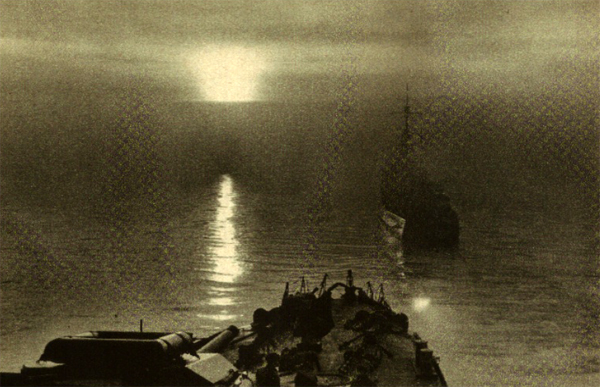
German destroyer in the North Sea
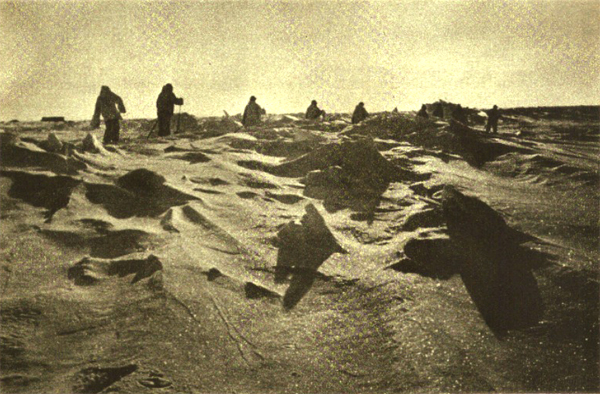
Ski troops occupies the island in the Finnish Bay

On the airfield in Ukraine. After returning from the mission air crews procceed to their lodgings
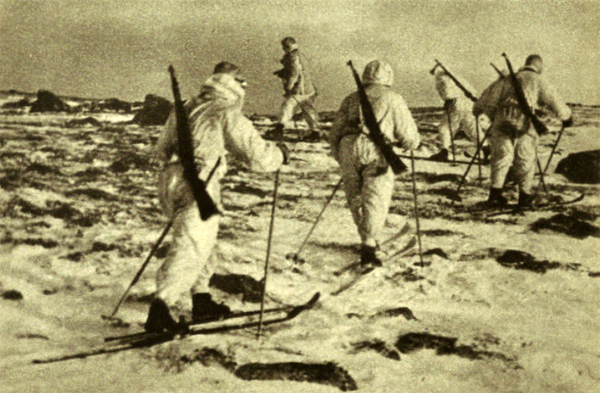
German ski troops on the march
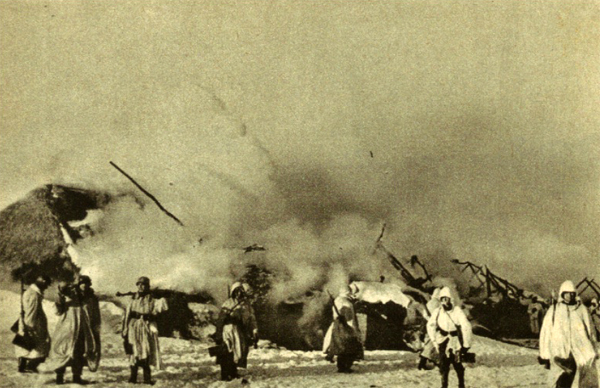
The storm troops dressed in white clothings gather after the successful fight for the village

The blizzard roars above the steppe
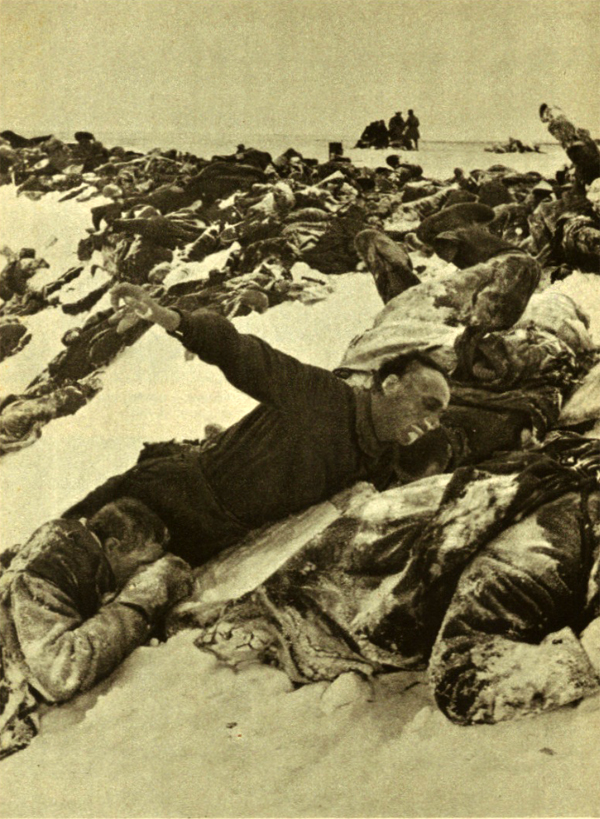
Soviet night attack on the central front sector was crushed by the German defensive fire. The bolshevist winter offensive turns into a mass suicide
